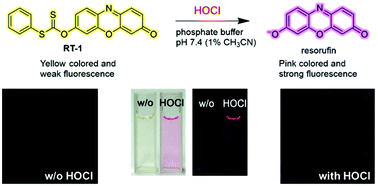A simple hypochlorous acid signaling probe based on resorufin carbonodithioate and its biological application†
Abstract
A novel hypochlorous-acid-selective signaling probe based on the carbonodithioate derivative of resorufin (RT-1) was developed. Probe RT-1 showed prominent colorimetric and turn-on type fluorescence signaling behavior exclusively toward hypochlorous acid, induced by oxidative hydrolysis, to regenerate resorufin dye. Hypochlorous acid signaling was not affected by the presence of common metal ions and anions as background, except for the redox active bromide and iodide anions. The detection limit of RT-1 for hypochlorous acid was found to be 2.18 × 10−9 M (0.11 ppb), and the signaling was completed within 3 min. It was also confirmed that hypochlorous acid signaling by the carbonodithioate-based probe RT-1 was superior to that of the closely related carbonothioate derivative RT-2. This was rationalized by density functional theory calculations, which demonstrated that the C![[double bond, length as m-dash]](https://www.rsc.org/images/entities/char_e001.gif) S sulfur atom of the former is more negatively charged than that of the latter. Finally, as a biological application of the probe, visualization of hypochlorous acid in RAW 264.7 murine macrophages and HeLa cells was successfully conducted to detect the cellular response to hypochlorous acid.
S sulfur atom of the former is more negatively charged than that of the latter. Finally, as a biological application of the probe, visualization of hypochlorous acid in RAW 264.7 murine macrophages and HeLa cells was successfully conducted to detect the cellular response to hypochlorous acid.



 Please wait while we load your content...
Please wait while we load your content...